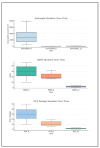Immunological Markers Associated with Skin Manifestations of EGPA
- PMID: 40806600
- PMCID: PMC12347103
- DOI: 10.3390/ijms26157472
Immunological Markers Associated with Skin Manifestations of EGPA
Abstract
Eosinophilic Granulomatosis with Polyangiitis (EGPA) is a rare systemic vasculitis with eosinophilic inflammation and variable clinical presentations. Although skin manifestations are frequent, current classification criteria do not include them, which may underestimate their diagnostic value. This prospective observational study aimed to assess systemic and skin involvement as well as eosinophilia, anti-neutrophil cytoplasmic antibody (ANCA), and Anti-nuclear antibodies (ANA) serum levels in 20 EGPA patients followed for one year at the University Hospital of Messina, Italy, before starting Mepolizumab, 300 mg. Eosinophilia, ANCA status, systemic and skin involvement were also evaluated at 6 and 12 months; a literature review on these data supplements our findings. Skin involvement was present in 55% of patients, including purpura, urticarial vasculitis, angioedema, maculopapular rash, and nodules, mostly in ANCA-negative patients, though purpura was more frequent in ANCA-positive cases but without any statistically significant correlation. ANAs were present in 50% of patients, together with ANCA in two subjects and without in eight. Mepolizumab significantly reduced eosinophil levels, BVASs, and corticosteroid dependence, with notable improvement in skin symptoms. In conclusion, skin manifestations are common in EGPA and may represent useful indicators of disease activity. Their integration with ANCA status, eosinophil counts, and positivity to other autoantibodies could enhance diagnostic and monitoring strategies identifying different clusters of EGPA patients even if the small sample size limits the generalizability of the findings.
Keywords: ANA; ANCA; Mepolizumab; angioedema; eosinophilia; eosinophilic granulomatosis with polyangiitis; nodules; purpura; skin manifestations; urticarial vasculitis.
Conflict of interest statement
The authors declare no conflicts of interest.
Figures







Similar articles
-
MPO-ANCA-positive eosinophilic granulomatosis with polyangiitis complicated by alveolar haemorrhage treated with mepolizumab as an induction therapy: Case report.Mod Rheumatol Case Rep. 2025 Jul 25;9(2):rxae088. doi: 10.1093/mrcr/rxae088. Mod Rheumatol Case Rep. 2025. PMID: 39707621
-
Two unique cases of eosinophilic granulomatosis with polyangiitis in childhood treated with anti-interleukin-5 therapy: infantile-onset and submandibular salivary gland involvement.Pediatr Rheumatol Online J. 2025 Jun 2;23(1):60. doi: 10.1186/s12969-025-01115-1. Pediatr Rheumatol Online J. 2025. PMID: 40457436 Free PMC article.
-
Mepolizumab efficacy and safety in patients with eosinophilic granulomatosis with polyangiitis in real practice: Data from a Spanish retrospective multicentric register from Rheumatology departments.Reumatol Clin (Engl Ed). 2025 Jan;21(1):101806. doi: 10.1016/j.reumae.2025.101806. Reumatol Clin (Engl Ed). 2025. PMID: 39894626
-
Anti-IL5/IL-5 receptor therapies for eosinophilic granulomatosis with polyangiitis: an updated Systematic Review.Front Immunol. 2025 Jul 22;16:1587158. doi: 10.3389/fimmu.2025.1587158. eCollection 2025. Front Immunol. 2025. PMID: 40766318 Free PMC article.
-
Dupilumab-induced Eosinophilic Granulomatosis with Polyangiitis Complicated by Peripheral Neuropathic Pain: a Case Report and Literature Review.J Clin Immunol. 2025 Jul 24;45(1):114. doi: 10.1007/s10875-025-01914-x. J Clin Immunol. 2025. PMID: 40705100 Free PMC article. Review.
References
-
- Jakes R.W., Kwon N., Nordstrom B., Goulding R., Fahrbach K., Tarpey J., Van Dyke M.K. Burden of illness associated with eosinophilic granulomatosis with polyangiitis: A systematic literature review and meta-analysis. Clin. Rheumatol. 2021;40:4829–4836. doi: 10.1007/s10067-021-05783-8. - DOI - PMC - PubMed
Publication types
MeSH terms
Substances
LinkOut - more resources
Full Text Sources
Medical

